Film & Movies
The Sad Tale of Disney’s Secret Lab
Using “Kangaroo Jack” as his jumping off point, Jim Hill reveals how short sighted Disney studio execs robbed the Mouse House of its one big chance to become a major player in the digital film-making field.
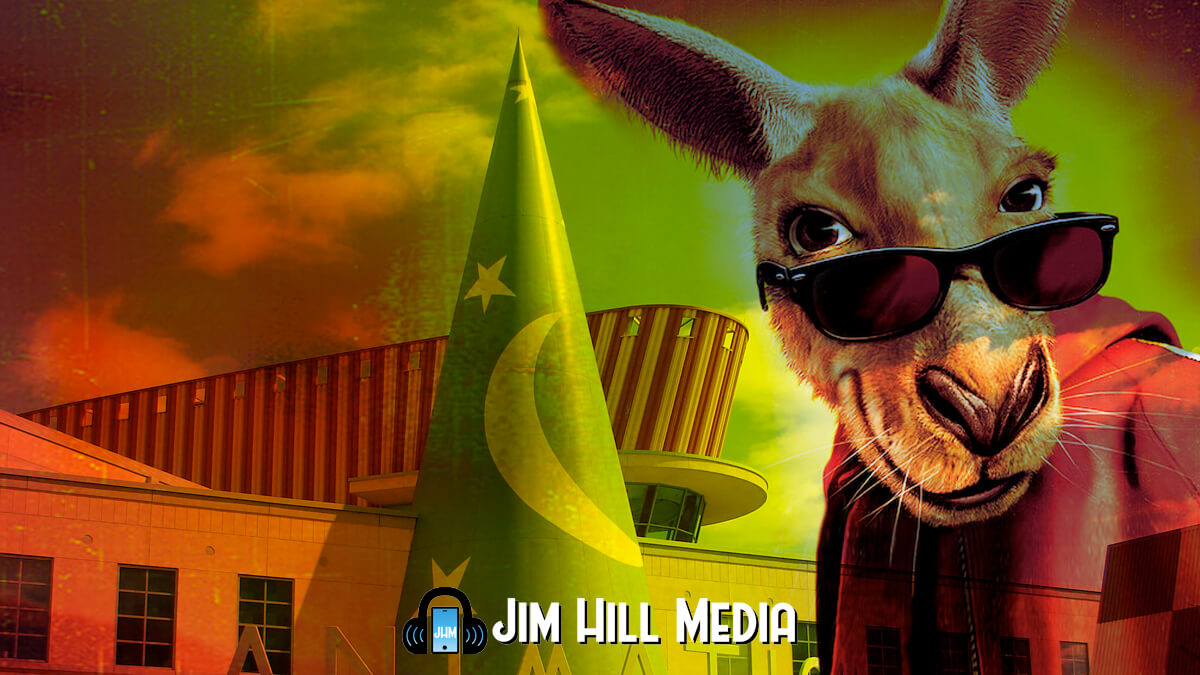
Have you seen those ads for “Kangaroo Jack” that have been all over the television lately? They make me sad.
Why for? Well, it’s not because I think that this Jerry O’Connell comedy is going to be particularly awful. But rather, because this Castle Rock / Warner Bros. film is the very last picture that Disney’s Secret Lab worked on.
What is Disney’s Secret Lab?
You all remember the Secret Lab, don’t you?
That state-of-the-art CG character animation and visual effects facility that the Mouse announced with much hoopla back in October 1999?
At the time, Mickey seriously thought that this digital movie-making operation would soon put Disney in the same league as Pixar and George Lucas’ ILM.
Less than two years later, Disney abruptly announced that it would be shutting down the Secret Lab.
Why did Mickey pull the plug? Not because the top flight animators and FX artists who worked at TSL did shoddy work. But because poor planning and short sighted-ness on the part of Disney studio execs.
Like I said earlier, this is a really sad story, folks. One that relates one of the greatest wastes of talent and resources in Hollywood history.
Disney Studios Acquires Dream Quest Images
Oddly enough, our tale begins on a somewhat upbeat note ‘way back in 1996, when Walt Disney Studios announced that it would be acquiring Dream Quest Images.
Dream Quest was one of the very best effects houses in the business.
Co-founded by industry legend Hoyt Yeatman, this company had done Oscar-winning work for James Cameron’s 1989 spiritual undersea epic, “The Abyss.” DQ had also done (literally) eye-popping work for the 1990 sci-fi thriller, “Total Recall,” as well as some superior sub stuff for the Mouse House’s own 1995 undersea adventure, “Crimson Tide.”
It was actually those submarine sequences that Dream Quest crafted so skillfully for this Denzel Washington / Gene Hackman action epic that caught the eye of Michael Eisner. Over the past few years, Disney’s CEO had become convinced that the studio’s own FX operation — Buena Vista Visual Effects — just wasn’t up to the task of competing with the likes of ILM.
Whereas Hoyt and his boys … well, Yeatman had had a hand in the creation of some of the most impressive visual effects films ever made (I.E. “Close Encounters of the Third Kind” and “Star Trek: The Motion Picture” to name just a few). So it stands to reason (to Uncle Michael’s way of thinking, anyway) that Hoyt and his Dream Quest Images crew could help Disney become competitive once more in the field of visual effects.
So Eisner ordered that Buena Vista Visual Effects be dissolved and that Dream Quest Images be installed as Disney’s new in-house effects operation. (Were the folks at BVVE upset with Uncle Michael’s decision? Well, the very last film that Buena Vista Visual Effects worked on was Paramount Pictures’ “Escape from LA.” Which — as part of its action-packed finale — featured an epic gun battle in the Main Street U.S.A. area of a long abandoned Disneyland. Which the staff of BVVE rendered in loving detail. Co-incidence? I don’t think so … Anyway …)
And — for the next three years — Dream Quest Images did absolutely beautiful work for the Mouse House. Creating killer effects sequences for Touchstone Pictures’ projects like “Armageddon” and “Con Air,” as well as memorable CG characters like Shep (the elephant who thought that he was a dog) in Walt Disney Pictures’ “George of the Jungle.”
Dream Quest Competing with Pixar – Creating Disney’s Secret Lab
And Hoyt and his Dream Quest team would still probably be working for Mickey, churning out superior FX, if some enterprising Disney executive hadn’t gotten the idea that there might be a better way of doing things. That maybe Disney could combine all of DQ’s effects wizards with all the guys who do CGI for Walt Disney Feature Animation and create …
Well, to be honest, what Disney was really looking to do was create a division of the corporation that would be capable of taking on Pixar Animation Studios. Then, as now, there were concerns that Steve Jobs would eventually walk away from his co-production deal with the Mouse. Which would then force Disney to enter into direct competition with Pixar.
And Disney desperately wanted to be ready to face that situation (should it actually ever come down to that). Which is why it opted to merge Hoyt Yeatman’s Dream Quest crew and certain elements of Disney Feature Animation together to form “The Secret Lab.”
It should be noted here that lots of folks at WDFA found that “Secret Lab” name to be pretty pretentious. Which is (perhaps) why they went out of their way to make fun of it as soon as possible. (Why else do you think that Ezma — as she was getting ready to have her revenge on Kuzco in “The Emperor’s New Groove” — turned to Kronk and said “Quick! To the secret lab”?)
Well, even if the studio’s other animators were making fun of the “Secret Lab”‘s name, Disney execs were certainly taking the launch of this whole new division of WDFA very seriously. I mean, why else would the Mouse have poured tens of millions of dollars into retooling one of Lockheed’s old “Skunk Works” building out by the Burbank airport in order to create a state-of-the-art production facility for the Secret Lab and its staff?
Did Disney ever have any second thoughts about throwing all this money around while it got the Secret Lab up out of the ground? It didn’t seem so. And why was that? Because the Mouse was positive that it had an ace up its sleeve. A film that just couldn’t miss with the public: “Dinosaur.”
Disney’s Dinosaur (2000 film)
And why couldn’t “Dinosaur” miss with the public? Because Disney executives knew that little kids just loved dinosaurs. I mean, look at how popular those “Land Before Time” videos are. That series is up to its ninth installment now (“Journey to Big Water”) and shows absolutely no sign of stopping. Each year, those direct-to-video sequels to that Don Bluth dino flick earn tens of millions of dollars for Universal Studios.
Disney knew that an animated film that features these prehistoric creatures would go over big-time with movie-goers. Particularly a movie that used digital film-making techniques to overlay hyper-detailed CG dinosaurs on top of live action background plates. Which would create a totally life-like illusion. Something that movie-goers had never seen at the multi-plex before: realistic dinosaurs.
If all went according to plan, “Dinosaur” would be a huge hit at the box office. Garnering great reviews as well as racking up huge grosses at movie theaters around the world. Then the Mouse’s competitors — who would be anxious to cash in on this new digital movie-making craze that would erupt in the wake of “Dinosaur”‘s enormous success — would come crawling. Begging Mickey, offering up large piles of money, if Disney would just allow the folks at the Secret Lab to produce a few eye-popping effects sequences for their upcoming movies.
This is honestly how Disney executives saw the whole “Dinosaur” scenario playing out. They were so supremely confident that they never gave any thought to the idea that the competition might be working on the very same idea.
Which is why the Mouse was caught flat-footed when the Discovery Channel aired “Walking with Dinosaurs,” that cable network’s own CG-prehistoric-creatures-overlaid-on-top-of-live-action-background plates in April 2000 (a full two months before “Dinosaur” was due to hit theaters). This BBC mini-series (produced at a 10th of the cost of Disney’s “Dinosaur,” by the way) totally stole the Secret Lab’s thunder.
What was once supposed to be a unique event in cinema history now looked like a TV rerun. Which is why “Dinosaur” under-performed at the box office. Though it did pull in an impressive $38 million on its opening weekend, the film eventually ran out of steam. Earning just $137 million during its entire domestic run. Which wasn’t exactly a flop. But — due to the movie’s extremely high production costs — “Dinosaur” didn’t even come close to breaking even. Let alone covering the additional tens of millions that the Mouse spent on promoting the picture.
It had honestly never occurred to Disney executives that “Dinosaur” might be a box office disappointment. That the film would not be a smashing success. Which is why the studio had no contingency plan in place for its Secret Lab.
According to the animators that I’ve spoken with, it had always been assumed that — once “Dinosaur” opened — the staff of the Secret Lab would get right to work on a sequel to the film. Using the very same wire frame and live action background plates to create the further adventures of Aladar and family. (Thereby giving the Walt Disney Company a way to get a taste of all that “Land Before Time” dough.)
This was what the Secret Lab was supposed to be doing from 2000 to 2002, as it also went about creating innovative new special effects sequences for Disney Studio films (as well as any of the Mouse’s competitors who would be willing to pay Mickey top dollar for TSL’s services). But — when it became apparent that there was no need to begin production of a sequel to “Dinosaur” — the big question was: What do we do with the Secret Lab now?
The Dismantling of Disney’s Secret Lab
That’s when WDFA executives decided to put a picture that still had a lot of story problems on the TSL production track. So the staff of the Secret Lab spent at least six months (and as much as $20 million) working on “Wild Life,” the bizarre tale of an elephant who somehow became a sensation on the New York City club circuit.
Okay. I know. That sounds like a kind of an odd story to build a Disney animated cartoon around. But the thing of it is … “Wild Life” directors Howard Baker and Roger Gould weren’t actually out to create your typical Disney animated film. They were hoping that — once “Wild Life” was completed — this CG feature (with its adult-tinged humor) might be released under the Touchstone Pictures label or even (perhaps) through Miramax.
Unfortunately, the project never got far enough along in production for this option to even be seriously considered. In the fall of 2000, Roy Disney caught a work-in-progress screening of “Wild Life” and — appalled by the film’s adult humor (I’m told that one joke in particular – where one gay character teased another gay character, as they were entering the New York City sewer system, for claiming that he’d never been down a man hole before — really set Roy off) — immediately ordered that production of the picture be shut down.
So — with no “Dinosaur” sequel on the horizon and “Wild Life” suddenly DOA — the brass at WDFA felt that they had little choice but to begin laying off animators and FX artists at the Secret Lab.
Some 110 people were let go during TSL’s first lay-off. Which was really unfortunate, given that — now that Yeatman’s FX department had suffered such deep staff cuts — it found itself unable to handle (all on its own) the few big special effects pictures that Disney would toss their way.
Case in point: Touchstone’s 2000 release, “Mission to Mars.” When Disney decided to accelerate production of this Brian DePalma picture (in order to beat Warner Bros.’ own Mars-based movie — “Red Planet” — into theaters), Hoyt didn’t have enough people on hand to handle all of the FX shots necessary to complete this picture. Which is why Mickey was forced to ask ILM to take on several key visual effects sequences for “M2M.”
And — when word got out that the Secret Lab wasn’t actually able to handle the few feature assignments that Disney studio brass had given it — that made film-makers nervous about using Yeatman and his crew to do their Mouse House pictures. This is reportedly why Michael Bay wouldn’t allow the Secret Lab to do the finished effects for his Summer 2001 film, “Pearl Harbor.” Oh, Michael was perfectly happy to let Hoyt’s team do all the pre-visualization of the film’s FX shots. Just not the finished work. Which is why ILM ended up doing most of the visual effects for “Pearl Harbor.”
Which just wasn’t fair. Given that Hoyt and the artists that remained with the Secret Lab really were capable of doing truly superior FX work. Just look how they handled that train wreck sequence in M. Night Shymalan’s 2000 hit, “Unbreakable.” Or all of those CGI puppies that were used in “102 Dalmatians.”
Yeatman and his crew kept hoping that a film would come along that would really show what the Secret Lab was capable of doing. And Disney almost did put a picture like that into production: “The Gemini Man.” A special effects-laden thriller that told the tale of a professional hit man who was being stalked by his 20-year old clone.
Unfortunately, in spite of some really impressive test footage that TSL put together (which showed Mel Gibson’s character from 1982’s “The Year of Living Dangerously” seemingly interacting with Mel’s character from 1999’s “Payback”), Disney opted not to go forward with “Gemini Man” immediately. The projected cost of the film (as well as the difficulty that the studio had in landing a bankable star like Gibson or Harrison Ford) forced the Mouse to postpone production for a while. The studio even hired screenwriter Jonathan Hensleigh to rewrite Darren Lemke’s original script for “Gemini Man” in order to make the film easier to shoot, lowering production costs.
But — as Howard and his crew waited for Hensleigh to finish his revamp of the “Gemini Man”‘s script — the staff of the Secret Lab found themselves further and further out of the loop. With Disney Studio executives reportedly refusing even to return their phone calls to find out what was going to become of TSL.
The breakdown in communication between senior Disney Studio staffers and Secret Lab personnel got so bad in the Spring in 2001 that Yeatman was reportedly forced to take drastic measures.
Some of you may recall — as part of the promotion for “Atlantis: The Lost Empire” — that Disney Auctions offered animation fans a unique opportunity: whoever bid the highest on eBay could win the right to have lunch with Roy Disney in the exclusive executive dining room in the Team Disney Burbank building.
Well, Hoyt and his crew had supposedly grown so desperate to meet with someone in Disney management to discuss what was going on with the Secret Lab that they began bidding on this lunch with Roy. Just so Walt’s nephew would then be forced to sit down with Yeatman and explain what WDFA executives intended to do with TSL.
Unfortunately, Hoyt allegedly lost out on that auction. Supposedly getting outbid at the very last minute by some un-named individual who ponied up $12,000 just for the privilege of breaking bread with Roy Jr. So the TSL staff went back to doing they’d done for the last six months: small filler assignments, like animating a CG version of the Magic Mirror from Disney’s “Snow White and the Seven Dwarfs” to serve as the host of the Platinum Collector’s edition of that film’s DVD.
In October 2001, the ax finally fell. Disney officially announced that it would be shutting the Secret Lab and that — from here on in — it would be farming out the studio’s visual effects assignments to other FX houses like ILM. As a direct result of this decision, over 300 animators and FX artists lost their jobs.
Yeatman (who I keep hearing is a pretty decent guy) stayed behind to supervise the transition. Overseeing a skeleton crew as they completed the CG dragons for Touchstone Pictures’ Summer 2002 release, “Reign of Fire,” as well as the CG kangaroos for WB’s “Kangaroo Jack.” Now that that picture has finally been buttoned up … who knows what Hoyt’s next move will be?
So that’s it in a nutshell, kids. The sad, sad story of the Walt Disney Company’s great experiment in digital film-making which flamed out after just two years.
And you want to know the REALLY sad part? All of these visual effects artists that Disney let go? They’re now working for Disney’s direct competition. Creating great FX sequences for films like “Spiderman,” “Stuart Little 2,” and “Star Wars: Episode II – Attack of the Clones.”
You see what I’m saying here? Walt Disney Studios appears to be having a really rough time lately because its pictures haven’t been nearly as appealing to movie-goers as big FX-laden epics like “The Two Towers” and “Harry Potter and the Chamber of Secrets.” Unfortunately, the very people who could have helped pull the Mouse out of this hole aren’t available anymore because Disney execs can’t plan ahead anymore. These suits couldn’t see that — given the way that the rest of the industry was aggressively embracing digital film-making — that they might actually need Hoyt Yeatman and his Secret Lab staff in the not-so-distant future.
All these Disney execs saw was an immediate cost savings for the corporation if they shut down the Secret Lab. Which is why they went for it. Walking briskly away from that $100 million-plus investment in hardware and talent. All just to save a few bucks.
It’s that exact quality that I personally find so exasperating about the Walt Disney Company’s current management team. No one thinks ahead anymore. These days, everyone in the executive suite is concentrating on how they can look good right now. What they can do today that will guarantee that they still have a job tomorrow. It’s all short term thinking. With little thought as to what the long term ramifications of today’s actions might be.
Given the success of recent FX heavy pictures like “The Two Towers” … I’m now certain that there are Disney Studio execs who realize that it was a mistake to shut down the Secret Lab (or — at the very least — to not have any other animated projects lined up for TSL beyond that “Dinosaur” sequel and the ill-fated “Wild Life”). Particularly now that Disney wants to have its affordable version of “The Alamo” out in theaters in time for the 2003 holiday season.
So who are they going to get now to create those thousands of CG Mexican soldiers to storm the fort in this film? I’m guessing ILM. I’m also betting that George Lucas will make Mickey pay through the nose for the privilege of using his FX artists.
Which is just so sad. Why? Because Disney Studios really could have handled this John Lee Hancock picture in-house if they’d just thought ahead a few moves and kept the Secret Lab alive.
Well, the secret’s out now. The Walt Disney Company lost out on the chance to be a major player in the digital film-making field. All because Disney studio executives’ idea of advance planning seems to be something along the lines of “What am I doing this coming weekend?”
Now do you understand why a TV commercial that features a rapping kangaroo makes me sad?
Your thoughts?
Film & Movies
How Disney’s “Bambi” led to the creation of Smokey Bear

When people talk about Disney’s “Bambi,” the scene that they typically cite as being the one from this 1942 film which then scarred them for life is – of course – the moment in this movie where Bambi’s mother gets shot by hunters.
Which is kind of ironic. Given that – if you watch this animated feature today – you’ll see that a lot of this ruined-my-childhood scene actually happens off-camera. I mean, you hear the rifle shot that takes down Bambi’s Mom. But you don’t actually see that Mama Deer get clipped.
Now for the scariest part of that movie that you actually see on-camera … Hands down, that has to be the forest fire sequence in “Bambi.” As the grown-up Bambi & his bride, Faline, desperately race through those woods, trying to find a path to safety as literally everything around them is ablaze … That sequence is literally nightmare fuel.
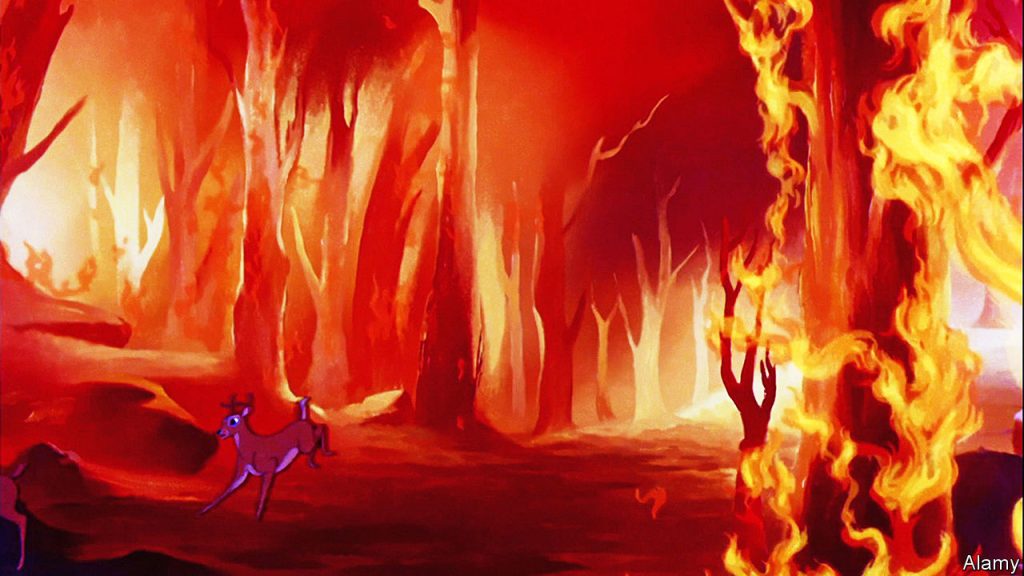
Mind you, the artists at Walt Disney Animation Studios had lots of inspiration for the forest fire sequence in “Bambi.” You see, in a typical year, the United States experiences – due to either natural phenomenon like lightning strikes or human carelessness – 100 forest fires. Whereas in 1940 (i.e., the year that Disney Studios began working in earnest of a movie version of Felix Salten’s best-selling movie), America found itself battling a record 360 forest fires.
Which greatly concerned the U.S. Forest Service. But not for the reason you might think.
Protecting the Forest for World War II
I mean, yes. Sure. Officials over in the Agricultural Department (That’s the arm of the U.S. government that manages the Forest Service) were obviously concerned about the impact that this record number of forest fires in 1940 had had on citizens. Not to mention all of the wildlife habitat that was now lost.
But to be honest, what really concerned government officials was those hundreds of thousands of acres of raw timber that had been consumed by these blazes. You see, by 1940, the world was on the cusp of the next world war. A conflict that the U.S. would inevitably be pulled into. And all that now-lost timber? It could have been used to fuel the U.S. war machine.
So with this in mind (and U.S. government officials now seeing an urgent need to preserve & protect this precious resource) … Which is why – in 1942 (just a few months after the Japanese bombed Pearl Harbor) – the U.S. Forest Service rolls out its first-ever forest fire prevention program.
Which – given that this was the early days of World War II – the slogan that the U.S. Forest Service initially chose for its forest fire prevention program is very in that era’s we’re-all-in-this-together / so-let’s-do-what-we-can-to-help-America’s war-effort esthetic – made a direct appeal to all those folks who were taking part in scrap metal drives: “Forest Defense is National Defense.”

And the poster that the U.S. Forest Service had created to support this campaign? … Well, it was well-meaning as well. It was done in the WPA style and showed men out in the forest, wielding shovels to ditch a ditch. They were trying to construct a fire break, which would then supposedly slow the forest fire that was directly behind them.
But the downside was … That “Forest Defense is National Defense” slogan – along with that poster which the U.S. Forest Service had created to support their new forest fire prevention program didn’t exactly capture America’s attention.
I mean, it was the War Years after all. A lot was going in the country at that time. But long story short: the U.S. Forest Service’s first attempt at launching a successful forest fire prevention program sank without a trace.
So what do you do in a situation like this? You regroup. You try something different.
Disney & Bambi to the Rescue
And within the U.S. government, the thinking now was “Well, what if we got a celebrity to serve as the spokesman for our new forest fire prevention program? Maybe that would then grab the public’s attention.”
The only problem was … Well, again, these are the War Years. And a lot of that era’s A-listers (people like Jimmy Stewart, Clark Gable, even Mel Brooks) had already enlisted. So there weren’t really a lot of big-name celebrities to choose from.
But then some enterprising official at the U.S. Forest Service came up with an interesting idea. He supposedly said “Hey, have you seen that new Disney movie? You know, the one with the deer? That movie has a forest fire in it. Maybe we should go talk with Walt Disney? Maybe he has some ideas about how we can better capture the public’s attention when it comes to our new forest fire prevention program?”
And it turns Walt did have an idea. Which was to use this government initiative as a way to cross-promote Disney Studio’s latest full-length animated feature, “Bambi.” Which been first released to theaters in August of 1942.
So Walt had artists at Disney Studio work up a poster that featured the grown-up versions of Bambi the Deer, Thumper the Rabbit & Flower the Skunk. As this trio stood in some tall grasses, they looked imploring out at whoever was standing in front of this poster. Above them was a piece of text that read “Please Mister, Don’t Be Careless.” And below these three cartoon characters was an additional line that read “Prevent Forest Fires. Greater Danger Than Ever!”
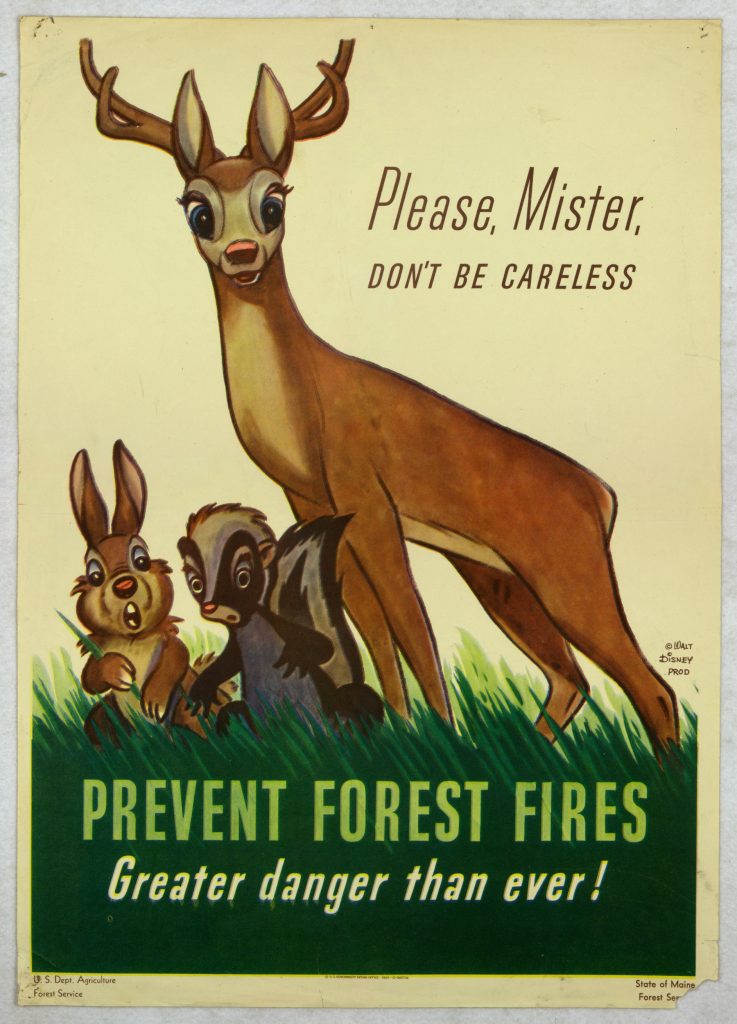
According to folks I’ve spoken with at Disney’s Corporate Archives, this “Bambi” -based promotional campaign for the U.S. Forest Service’s forest fire prevention campaign was a huge success. So much so that – as 1943 drew to a close – this division of the Department of Agriculture reportedly reached out to Walt to see if he’d be willing to let the U.S. Forest Service continue to use these cartoon characters to help raise the public’s awareness of fire safety.
Walt – for reasons known only to Mr. Disney – declined. Some have suggested that — because “Bambi” had actually lost money during its initial theatrical release in North America – that Walt was now looking to put that project behind him. And if there were posters plastered all over the place that then used the “Bambi” characters that then promoted the U.S.’s forest fire prevention efforts … Well, it would then be far harder for Mr. Disney to put this particular animated feature in the rear view mirror.
Introducing Smokey Bear
Long story short: Walt said “No” when it came to reusing the “Bambi” characters to promote the U.S. Forest Service’s forest fire prevention program. But given how successful the previous cartoon-based promotional campaign had been … Well, some enterprising employee at the Department of Agriculture reportedly said “Why don’t we come up with a cartoon character of our own?”
So – for the Summer of 1944 – the U.S. Forest Service (with the help of the Ad Council and the National Association of State Foresters) came up with a character to help promote the prevention of forest fires. And his name is Smokey Bear.
Now a lot of thought had gone into Smokey’s creation. Right from the get-go, it was decided that he would be an American black bear (NOT a brown bear or a grizzly). To make this character seem approachable, Smokey was outfitted with a ranger’s hat. He also wore a pair of blue jeans & carried a bucket.
As for his debut poster, Smokey was depicted as pouring water over a still-smoldering campfire. And below this cartoon character was printed Smokey’s initial catchphrase. Which was “Care will prevent 9 out of 10 forest fires!”
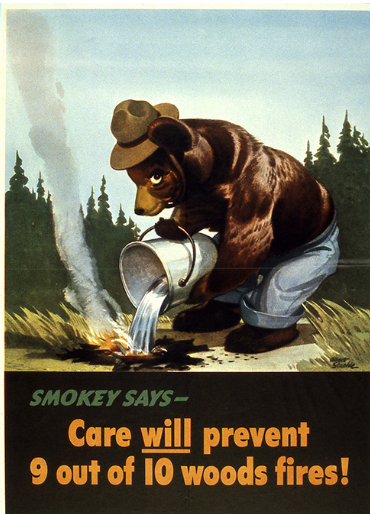
Which makes me think that this slogan was written by the very advertising executive who wrote “Four out of five dentists recommend sugarless gum for their patients who chew gum.”
Anyway … By the Summer of 1947, Smokey got a brand-new slogan. The one that he uses even today. Which is “Only YOU can prevent forest fires.”
The Real Smokey Bear
Now where this gets interesting is – in the Summer of 1950 – there was a terrible forest fire up in the Capitan Mountains of New Mexico. And over the course of this blaze, a bear cub climbed high up into a tree to try & escape those flames.
Firefighters were finally able to rescue that cub. But he was so badly injured in that fire that he was shipped off to the National Zoo in Washington, D.C. and nursed back to health. And since this bear really couldn’t be released back in the wild at this point, he was then put on exhibit.
And what does this bear’s keepers decide to call him? You guessed it: Smokey.
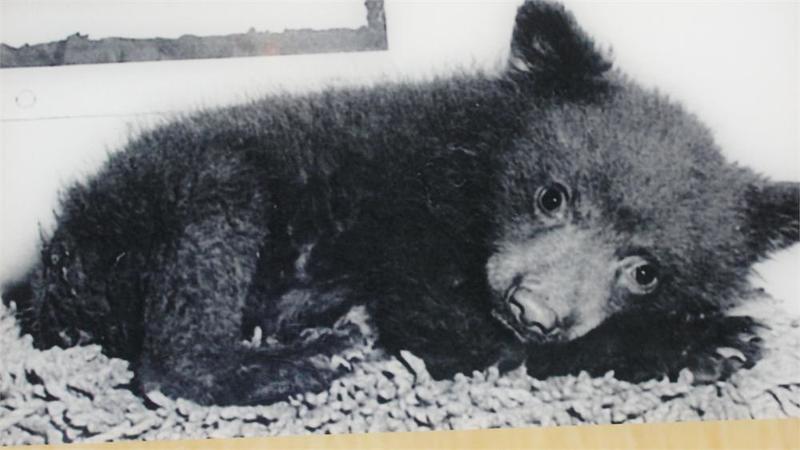
And due to all the news coverage that this orphaned bear got, he eventually became the living symbol of the U.S. Forest Service’s forest fire prevention program. Which then meant that this particular Smokey Bear got hit with a ton of fan mail. So much so that the National Zoo in Washington D.C. wound up with its own Zip Code.
“Smokey the Bear” Hit Song
And on the heels of a really-for-real Smokey Bear taking up residence in our nation’s capital, Steve Nelson & Jack Rollins decide to write a song that shined a spotlight on this fire-fightin’ bruin. Here’s the opening stanza:
With a ranger’s hat and shovel and a pair of dungarees,
You will find him in the forest always sniffin’ at the breeze,
People stop and pay attention when he tells them to beware
Because everybody knows that he’s the fire-preventin’ bear
Believe or not, even with lyrics like these, “Smokey the Bear” briefly topped the Country charts in the Summer of 1950. Thanks to a version of this song that was recorded by Gene Autry, the Singing Cowboy.
By the way, it was this song that started all of the confusion in regards to Smokey Bear’s now. You see, Nelson & Rollins – because they need the lyrics of their song to scan properly – opted to call this fire-fightin’-bruin Smokey THE Bear. Rather than Smokey Bear. Which has been this cartoon character’s official name since the U.S. Forest Service first introduced him back in 1944.
“The Ballad of Smokey the Bear”
Further complicating this issue was “The Ballad of Smokey the Bear,” which was a stop-motion animated special that debuted on NBC in late November of 1966. Produced by Rankin-Bass as a follow-up to their hugely popular “Rudolph the Red-Nosed Reindeer” (which premiered on the Peacock Network in December of 1964) … This hour-long TV show also put a “THE” in the middle of Smokey Bear’s name because the folks at Rankin-Bass thought his name sounded better that way.
And speaking of animation … Disney’s “Bambi” made a brief return to the promotional campaign for the U.S. Forest Service’s forest fire prevention program in the late 1980s. This was because the Company’s home entertainment division had decided to release this full-length animated feature on VHS.
What’s kind of interesting, though, is the language used on the “Bambi” poster is a wee different than the language that’s used on Smokey’s poster. It reads “Protect Our Forest Friends. Only You Can Prevent Wildfires.” NOT “Forest Fires.”
Anyway, that’s how Disney’s “Bambi” led to the creation of Smokey Bear. Thanks for bearin’ with me as I clawed my way through this grizzly tale.
Film & Movies
“Indiana Jones and the Search for Indiana Jones”
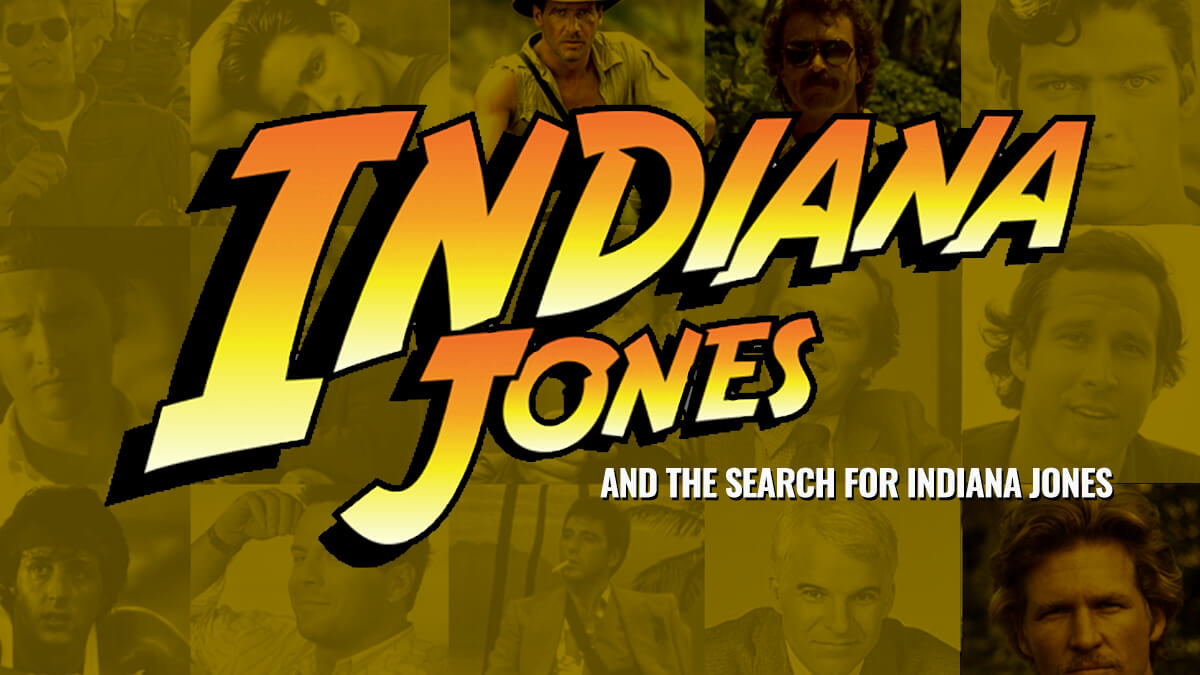
News came late last week that NBC was cancelling the “Magnum PI” remake. This series (which obviously took its inspiration from the Tom Selleck show that originally debuted on CBS back in December of 1980 and then went on run on that network for 8 seasons. With its final episode airing on May 8, 1988).
Anyway … Over 30 years later, CBS decided to remake “Magnum.” This version of the action drama debuted on September 24, 2018 and ran for four seasons before then being cancelled. NBC picked up the “Magnum” remake where it ran for one more season before word came down on June 23rd that this action drama was being cancelled yet again.
FYI: The second half of Season 5 of “Magnum” (10 episodes) has yet to air on NBC. It will be interesting to see when that final set of shows / the series finale gets scheduled.
This all comes to mind this week – out ahead of the theatrical release of “Indiana Jones and the Dial of Destiny” because … Well, if CBS execs had been a bit more flexible back in 1980, the star of the original version of “Magnum PI” (Tom Selleck) would have played the lead in “Raiders of the Lost Ark.” Which was released to theaters back on June 12, 1981.
That’s the part of the Indiana Jones story that the folks at Lucasfilm often opt to skim over.
That Harrison Ford wasn’t George Lucas’ first choice to play Doctor Jones.
Auditions for Indiana Jones – Harrison’s Not on the List
Mind you, Steven Spielberg – right from the get-go – had pushed for Ford to play this part. The way I hear it, Lucas showed Spielberg a work-in-progress cut of “The Empire Strikes Back.” And Steven was so taken with Harrison’s performance as Han Solo in that Irwin Kershner film that he immediately began pushing for Ford to be cast as Doctor Jones.
Whereas Mr. Lucas … I mean, it wasn’t that George had anything against Harrison. What with Ford’s performances first in “American Grafitti” and then in “A New Hope,” these two already had a comfortable working relationship.
But that said, Lucas was genuinely leery of … Well, the sort of creative collaboration that Martin Scorcese and Robert DeNiro. Where one actor & one director repeatedly worked together. To George’s way of thinking, that was a risky path to follow. Hitching your wagon to a single star.
Which is why – when auditions got underway for “Raiders of the Lost Ark” in 1979 — Mike Fenton basically brought in every big performer of that era to read for Dr. Jones except Harrison Ford. We’re talking:
- Steve Martin
- Chevy Chase
- Bill Murray
- Jack Nicholson
- Peter Coyote
- Nick Nolte
- Sam Elliot
- Tim Matheson
- and Harry Hamlin
Casting a Comedian for Indiana Jones
Please note that there are a lot of comedians on this list. That’s because – while “Raiders of the Lost Ark” was in development — Spielberg was directed his epic WWII comedy, “1941.” And for a while there, Steve & George were genuinely uncertain about whether the movie that they were about to make would be a sincere valentine to the movie serials of the 1930s & the 1940s or more of a spoof.
It’s worth noting here that three of the more ridiculous set pieces found in “Temple of Doom” …
- the shoot-out at Club Obi Wan in Shanghai
- Indy, Willie & Short Round surviving that plane crash by throwing an inflatable life raft out of the cargo hatch
- and that film’s mine cart chase (which was not only inspired by Disney theme park favorites the Matterhorn Bobsleds & Big Thunder Mountain Railroad but some of the sound effects that you hear in this portion of “Temple of Doom” were actually recorded after hours at Disneyland inside of these very same attractions)
… all originally supposed to be in “Raiders of the Lost Ark.” I’ve actually got a copy of the very first version of the screenplay that Lawrence Kasdan wrote for the first “Indy” movie where all three of these big action set pieces were supposed to be part of the story that “Raiders” told. And I have to tell you that this early iteration of the “Raiders” screenplay really does read more like a spoof of serials than a sincere, loving salute to this specific style of cinema.
Casting Indiana Jones – Jeff or Tom
Anyway … Back now to the casting of the male lead for “Raiders” … After seeing virtually every actor out in LA while looking for just the right performer to portray Indiana Jones, it all came down to two guys:
- Jeff Bridges
- and Tom Selleck
Jeff Bridges as Indiana Jones
Mike Fenton was heavily pushing for Jeff Bridges. Having already appeared with Clint Eastwood in 1974’s “Thunderbolt & Lightfoot” (Not to mention that “King Kong” remake from 1976), Bridges was a known quantity. But what Fenton liked especially liked about Bridges when it came to “Raiders” was … Well, at that time, Jeff was just coming off “Heaven’s Gate.”
Mind you, nowadays, because we’ve all now had the luxury of seeing the director’s cut of this Michael Cimino movie, we recognize “Heaven’s Gate” for the cinematic masterpiece that it is. But 40+ years ago, that honestly wasn’t the case. All audiences had to judge this movie by was the severely truncated version that United Artists sent out into theaters. Which – because “Heaven’s Gate” had cost $44 million to make and only sold $3.5 million of tickets – then became the textbook example of Hollywood excess.
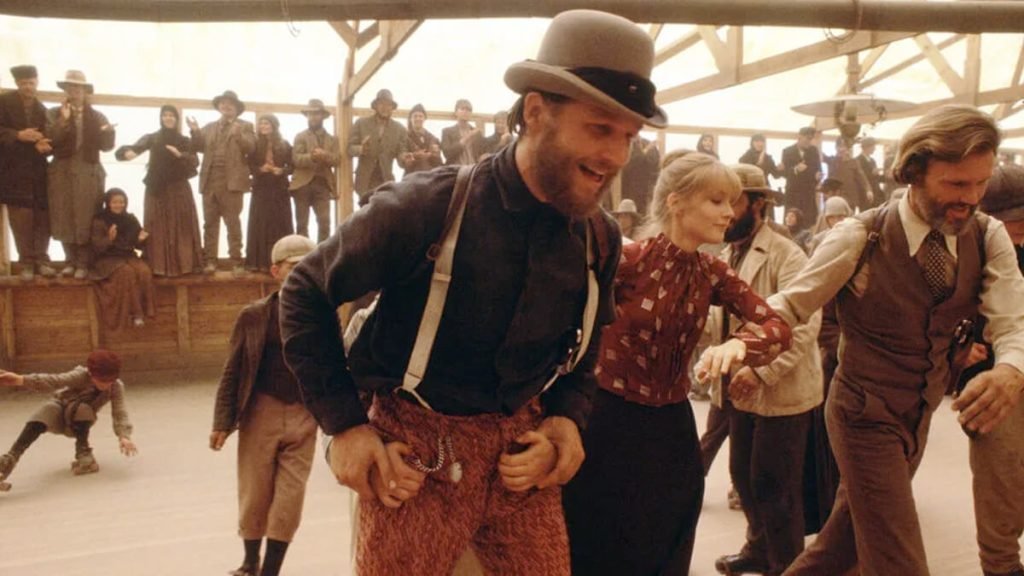
Long story short: Given that being associated with “Heaven’s Gate” had somewhat dinged Bridges’ reputation for being a marketable star (i.e., a performer that people would pay good money to see up on the big screen), Jeff was now looking to appear in something highly commercial. And the idea of playing the lead in a film directed by Steven Spielberg (the “Jaws” & “Close Encounter” guy) and produced by George Lucas (Mr. “Star Wars”) was very, very appealing at that time. Bridges was even willing to sign a contract with Spielberg & Lucas that would have then roped him into not only playing Indiana Jones in “Raider of the Lost Ark” but also to appear as this very same character in two yet-to-be-written sequels.
Better yet, because “Heaven’s Gate” had temporarily dimmed Bridges’ star status, Jeff was also willing to sign on to do the first “Indy” film for well below his usual quote. With the understanding that – should “Raiders of the Lost Ark” succeed at the box office – Bridges would then be paid far more to appear in this film’s two sequels.
That seemed like a very solid plan for “Raiders.” Landing a known movie star to play the lead in this action-adventure at a bargain price.
Ah, but standing in Mike Fenton’s way was Marcia Lucas.
Tom Selleck as Indiana Jones
Marcia Lucas, who had seen Tom Selleck’s audition for “Raiders” (And you can see it as well. Just go to Google and type in “Tom Selleck” and “Indiana Jones.” And if you dig around for a bit, you’ll then see a feature that Lucas & Spielberg shot for “Entertainment Tonight” back in 2008 [This story was done in support of the theatrical release of “Indiana Jones and the Kingdom of the Crystal Skull”]. And as part of this piece, George and Steve share Tom’s original audition for “Raiders.” And what’s genuinely fascinating about this footage is that Selleck’s scene partner is Sean Young. Who – at that time, anyway – was up for the role of Marion Ravenwood) and kept telling her husband, “You should cast this guy. He’s going to be a big star someday.”
And given that George was smart enough to regularly heed Marcia Lucas’ advice (She had made invaluable suggestions when it came to the editing of “American Graffiti” and the original “Star Wars.” Not to downplay George Lucas’ cinematic legacy, but Marcia Lucas was a world-class storyteller in and of her own right), Lucas then reached out to Spielberg and persuaded him that they should cast relative unknown Tom Selleck as Doctor Jones over the already well-known Jeff Bridges.
Now don’t feel too bad for Jeff Bridges. When he lost out on playing the lead in “Raiders of the Lost Ark,” Jeff then accepted a role in the very next, high profile, sure-to-be-commercial project that came along. Which turned out to be Disney’s very first “TRON” movie. Which was eventually released to theaters on July 9, 1982.
Back to Tom Selleck now … You have to remember that – back then – Selleck was the handsome guy who’d already shot pilots for six different shows that then hadn’t gone to series. Which was why Tom was stuck being the guest star on shows like “The Fall Guy” and “Taxi.” Whereas once word got out around town that Selleck was supposed to play the lead in a project that Spielberg was directed & Lucas was producing … Well, this is when CBS decided that they’d now take the most recent pilot that Tom had shot and then go to series with this show.
That program was – of course – the original “Magnum PI.” And it’s at this point where our story started to get complicated.
“Magnum PI” – Two Out of Three Say “Yes”
Okay. During the first season of a TV show, it’s traditionally the network – rather than the production company (which – in this case – was Glen A. Larson Productions. The company behind the original versions of “Battlestar Galactica” & “Knight Rider”) or the studio where this series is actually being shot (which – in this case – was Universal Television) that has all the power. And in this particular case, the network execs who were pulling all the strings behind-the-scenes worked for CBS.
And when it came to the first season of “Magnum PI,” CBS had a deal with Glen A. Larson Productions and Universal Television which stated that the talent which had been contracted to appear in this new action drama would then be available for the production of at least 13 episodes with an option to shoot an additional 9 episodes (This is known in the industry as the back nine. As in: the last nine holes of a golf course).
Anyway, if you take those initial 13 episodes and then tack on the back nine, you then get 22 episodes total. Which – back in the late 1970s / early 1980s, anyway – was what a full season of a network television show typically consisted of.
Anyway … The contract that Selleck had signed with Glen A. Larson Productions, Universal Television & CBS stated that he had to be available when production of Season One of “Magnum PI” began in March of 1980. More to the point, Tom also had to be available should CBS exercise its option to air 22 episodes of this new series on that television network over the course of “Magnum PI” ‘s first season.
Which then made things complicated for George Lucas & Steven Spielberg because … Well, in order for “Raiders of the Lost Ark” to make its June 12, 1981 release date, that then meant that production of the first “Indy” movie would have to get underway no later than June 23, 1980.
But here’s the thing: Production of Season One of “Magnum PI” was scheduled to run through the first week of July of that same year (1980). So in order for Tom Selleck to play Indiana Jones in “Raiders,” he was going to need to be wrapped on production of “Magnum PI” by June 22, 1980 at the absolute latest.
So Spielberg & Lucas went to Glen A. Larsons Productions and asked if Selleck could please be sprung from his “Magnum PI” contractual obligations by June 22nd. And they said “Yes.” Then Steven & George went to Universal Television and asked executives there for their help in clearing Tom’s schedule so that he’d then be available to start work on “Raiders.” And they say “Yes” as well.
Spielberg & Lucas now go to CBS. But instead of the quick “Yeses” that they got from officials at Glen A. Larson Productions and Universal Television, it takes those suits at the Tiffany Network weeks before they then decided to say “No, they couldn’t release Tom Selleck early to go work on ‘Raiders’ “ because …
I’ve never really been able to get a straight answer here as to why CBS execs dug in their heels here. Why they flat-out refused to release Selleck early from his “Magnum PI” contractual obligation and allow him to go shoot “Raiders.”
Payback from “The Star Wars Holiday Special” Trash Talk
That said, it is worth noting that “The Star Wars Holiday Special” aired on CBS back in November of 1978. And given that – in the years that followed — Lucas wasn’t exactly shy when it came to saying how much he hated that two hour-long presentation (Or – for that matter – how George really regretted caving into the requests of CBS execs. Who had insisted that television stars long associated with the Tiffany Network – people like Art Carney, Harvey Korman & Bea Arthur – be given prominent guest starring roles in “The Star Wars Holiday Special”). And I’ve heard whispers over the years that CBS executives preventing Tom Selleck from appearing in “Raiders” could be interpreted as the Tiffany Network getting some payback for what George had said publicly about the “Star Wars Holiday Special.”
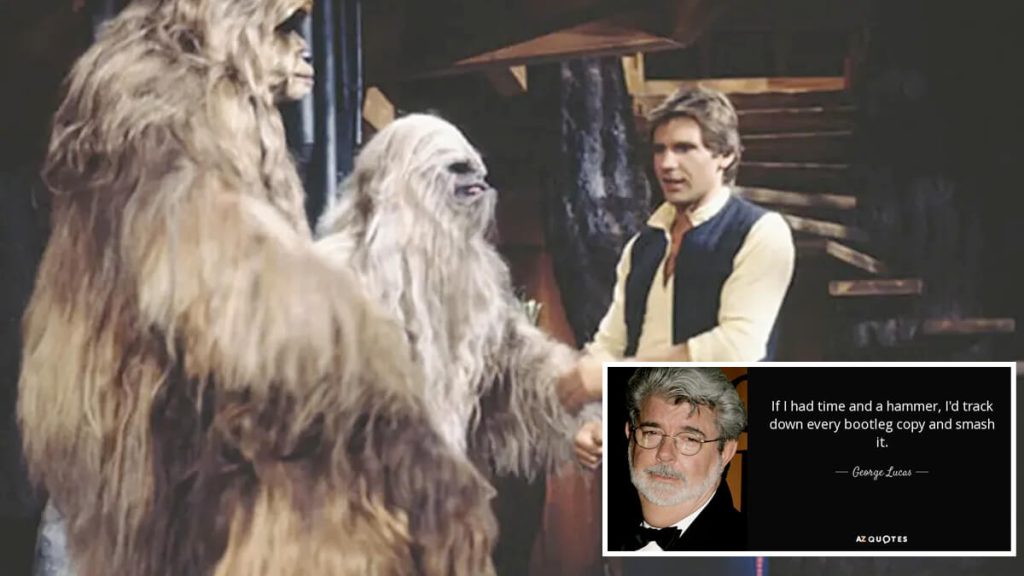
Harrison Ford Comes to Rescue “Indiana Jones”
Anyway … It’s now literally just weeks before production of “Raiders of the Lost Ark” is supposed to begin and Spielberg & Lucas have just learned that that they’ve lost their film’s star. CBS is flat-out refusing to release Tom Selleck early from his “Magnum PI” contractual obligation. So Steven & George now have to find someone else to play Indy … and fast.
The real irony here is … The American Federation of Television and Radio Artists would go on strike in the Summer of 1980. Which then shut prematurely shut down production of the first season of “Magnum PI.” (As a direct result, the first full season of this action drama to air on CBS only had 18 episodes, rather than the usual 22). And because this job action lasted ‘til October 23rd of that same year … Well, this meant that Tom Selleck would have actually been free to start shooting “Raiders of the Lost Ark” on June 23, 1980 because production of Season One of “Magnum PI” was already shut down by then due to that AFTRA strike.
But no one knew – in May of 1980, anyway – that this job action was going to happen in just a few weeks. All that Steven Spielberg & George Lucas knew was that they now needed a new lead actor for “Raiders.” And circling back on Jeff Bridges was no longer an option. As I mentioned earlier, Jeff had agreed to do “TRON” for Disney. And – in the interim – Bridges gone off to shoot “Cutter’s Way” for MGM / UA.
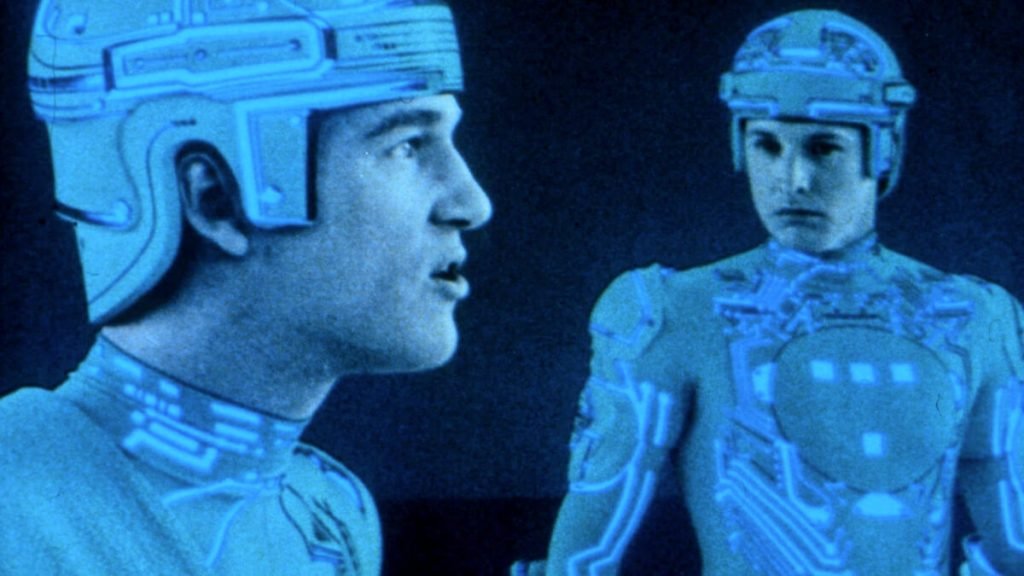
So this is where Harrison Ford enters the equation. As he recalls:
In May of 1980, I get a call from George Lucas. Who says ‘I’m messaging a script over to you this morning. As soon as it gets there, I need you to immediately read this script. Then – as soon as you’re done – I need you to call.
So the script arrives and it’s for ‘Raiders.’ I read it and it’s good. So I call George back and say ‘It’s good.’ And he then says ‘Would you be interested in playing Indy?’ I say that it looks like it would be a fun part to play.
George then says ‘ That’s great to hear. Because we start shooting in four weeks. Now I need you to meet with Steven Spielberg today and convince him that you’re the right guy to play Indy.’
Of course, given that Spielberg had been pushing for Ford to pay Indy ever since he had first seen that work-in-progress version of “The Empire Strikes Back” … Well, Harrison’s meeting with Steven was very, very short. And just a few weeks later, Spielberg, Lucas & Ford were all at the Port de la Pallice in La Rochelle. Where – on the very first day of shooting on “Raiders” (which – again – was June 23, 1980)– the scene that was shot was the one where that Nazi sub (the one that Indy had lashed himself to its periscope by using his bullwhip as a rope) was arriving at its secret base.
And all of this happened because Harrison immediately agreed to do “Raiders of the Lost Ark” when the part of Indy was first offered to him in mid-May of 1980.
Before “Star Wars” was “Star Wars”
So why such a quick yes? Well, you have to remember that “Empire Strikes Back” wouldn’t be released to theaters ‘til May 21, 1980. And no one knew at that time whether this sequel to the original “Star Wars” would do as well at the box office as “A New Hope” had back in 1977 (FYI: “Empire” would eventually sell over $500 million worth of tickets worldwide. Which is roughly two thirds of what the original “Star Wars” earned three years earlier).
More to the point, the four films that Harrison had shot right after “A New Hope” / prior to “Empire Strikes Back” (i.e., “Heroes” AND “Force 10 from Navarone” AND “Hanover Street” AND “The Frisco Kid”) had all under-performed at the box office. So to Ford’s way of thinking, taking on a role that Tom Selleck was no longer available to play – one that had the potential of spawning two sequels – seemed like a very smart thing to do. Especially after three years of cinematic stumbles.
By the way, whenever this topic ever comes up, Harrison Ford is very gracious. He always makes a point of saying that he’s grateful to have gotten this career opportunity. More to the point, that he still feels kind of bad that Tom Selleck never got the chance to play this part.
Tom Selleck After “Indiana Jones”
That said, we shouldn’t feel too bad for Tom Selleck. After all, the original “Magnum PI” proved to be a long running hit for CBS. And in an effort to smooth over any residual bad feelings that may have resulted from Tom being forced to give up “Raiders” back in May of 1980, Selleck was eventually allowed to create his own production company (i.e., T.W.S. Productions, Inc. As in Thomas William Selleck Productions). Which – after the fact – was then cut in on some of those “Magnum PI” -related revenue streams.
More to the point, while “Magnum PI” was on hiatus following its second year in production, Selleck flew off to Yugoslavia. Where he then shot his own Indiana Jones-esque film for theatrical release. Which was called “High Road to China” in the States, but – overseas – was promoted as “Raiders of the End of the World.”
FYI: Warner Bros. released “High Road to China” stateside 40 years ago this year. On March 18, 1983, to be exact. It didn’t do all that great at the box office. $28 million in ticket sales versus $15 million in production costs.
And over the years, there’s even been some talk of finding a way to maybe set things right here. By that I mean: Finally finding a way to officially fold Tom Selleck into the world of Indiana Jones.
Could Tom Selleck Work with Indiana Jones?
The way I hear it, between the time when “Indiana Jones and the Last Crusade” was theatrically released in May of 1989 and when “Indiana Jones and the Kingdom of the Crystal Skull” debuted in May of 2008, there were a number of ideas for Indiana Jones sequels tossed around. And from what I’ve been told, there was at least one treatment for a fourth Indiana Jones film written that proposed pairing up Harrison Ford & Tom Selleck. With the idea here being that Selleck was supposed to have played Ford’s brother.
Obviously that film was never made. And – no – I don’t know what state Indiana Jones’ brother was supposed to be named after.
This article is based on research for Looking at Lucasfilm “Episode 80”, published on June 29, 2023. Looking at Lucasfilm is part of the Jim Hill Media Podcast Network.
Film & Movies
Will “Metro” – that “Cars” Spin-Off Which Disney Developed – Ever Get Made?
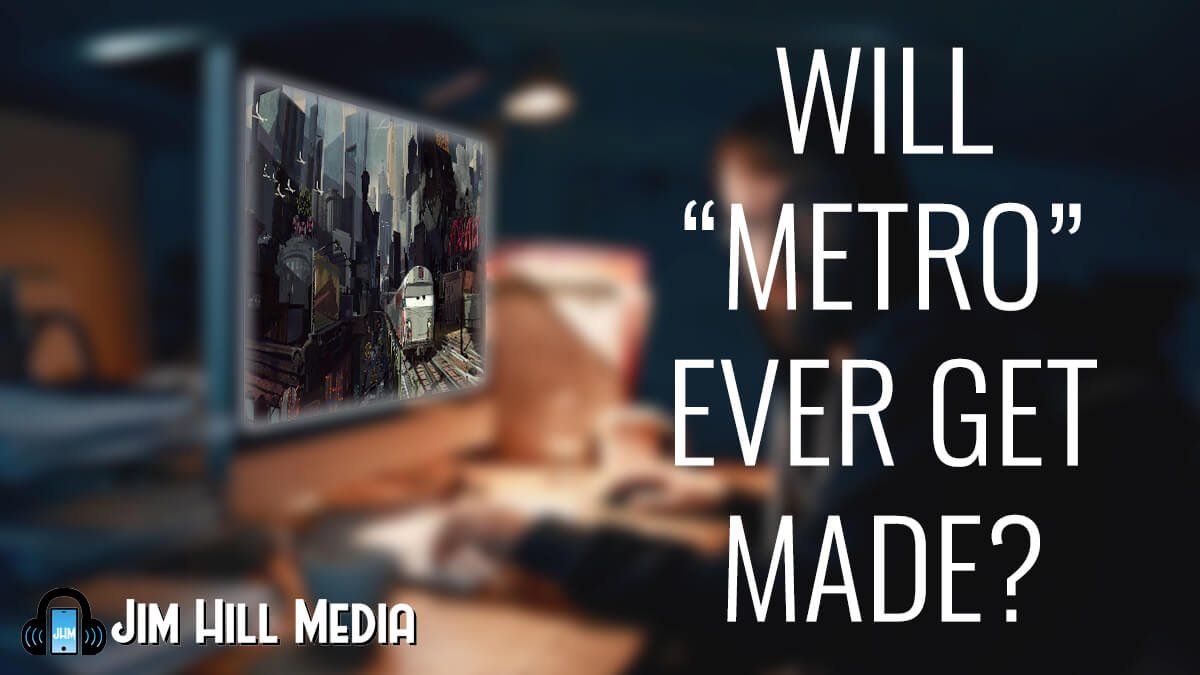
First came “Cars” in June of 2006.
This Pixar Animation Studios production did so well (Of all the high grossing films released that year, “Cars” was No. 2 at the box office. Only “Pirates of the Caribbean: Dead Man’s Chest” sold more tickets in 2006) that Disney execs asked John Lasseter to develop a sequel.
“Cars 2” came out in June of 2011 and also did quite well at the box office (It took the No. 7 slot in the Top-Ten-for-ticket-sales that year). Which is why Disney then asked Pixar to prep a follow-up film.
“Cars 3” would eventually arrive in theaters in June of 2017. But in the meantime, Disney & Pixar began exploring the idea of expanding this film franchise. Largely because the amount of money that the Mouse was making off of the sales of “Cars” -related merchandise was … To be blunt here, mind boggling.
Don’t believe me? Well, then consider this: In just the first five years that the “Cars” film franchise existed, global retail sales of merchandise related to these Pixar movies approached $10 billion. That’s billion with a “B.”
So is it any wonder that – while Pixar was still trying to get a handle on what “Cars 3” would actually be about – the Mouse (through its DisneyToon Studios arm. Which produced home premieres like those “TinkerBell” movies) began actively looking into ways to expand this lucrative franchise?
“Planes” – The First “Cars” Spin-Off
The first “Cars” spin-off to arrive in the marketplace was “Planes.” This Klay Hall film (which was set in “The World Above Cars”) was released theatrically in August of 2013, with the Blu-ray & DVD version of “Planes” hitting store shelves in November of that same year.
“Planes: Fire and Rescue” followed in the Summer of 2014. And while a “Planes 3” was definitely put in development (At the Disney Animation panel at the 2017 D23 Expo, John Lasseter not only shared a clip from this film. But he also revealed that this project – which, at that time, was entitled “Space” – was slated to be released theatrically in April of 2019) … This animated feature was abruptly cancelled when DisneyToon Studios was shuttered in June of 2018.
But wait. There’s more … In addition to the aborted “Planes 3,” Disney had other “Cars” spin-offs in the works. One was supposed to be built around boats. While yet another was supposed to have shined a spotlight on trucks.
“Metro” – The World Below Cars
And then there was “Metro.” Which was supposed to have been set in the inner city and focused on what went on in “The World Below Cars.” As in: Down in the subway system.
Just in the past week or so, a few pieces of concept art for “Metro” have surfaced online. Giving us all an intriguing look at what might have been. These preproduction paintings suggest that this “Cars” spin-off would be far grittier than … Say … the sort of adventures that Lightning McQueen & Mater would typically have out in Radiator Springs.
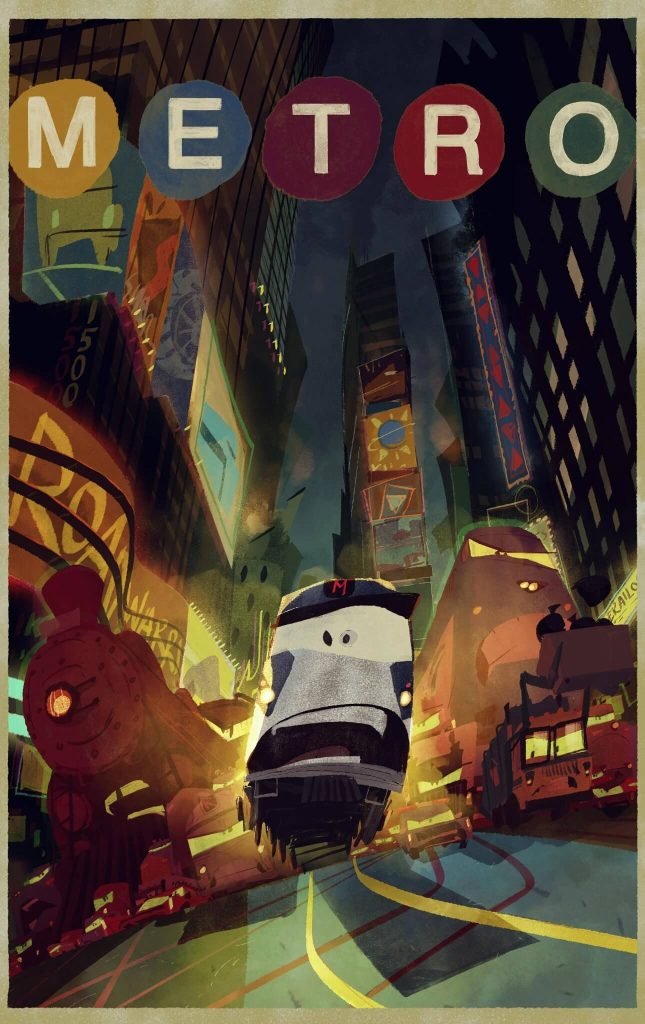
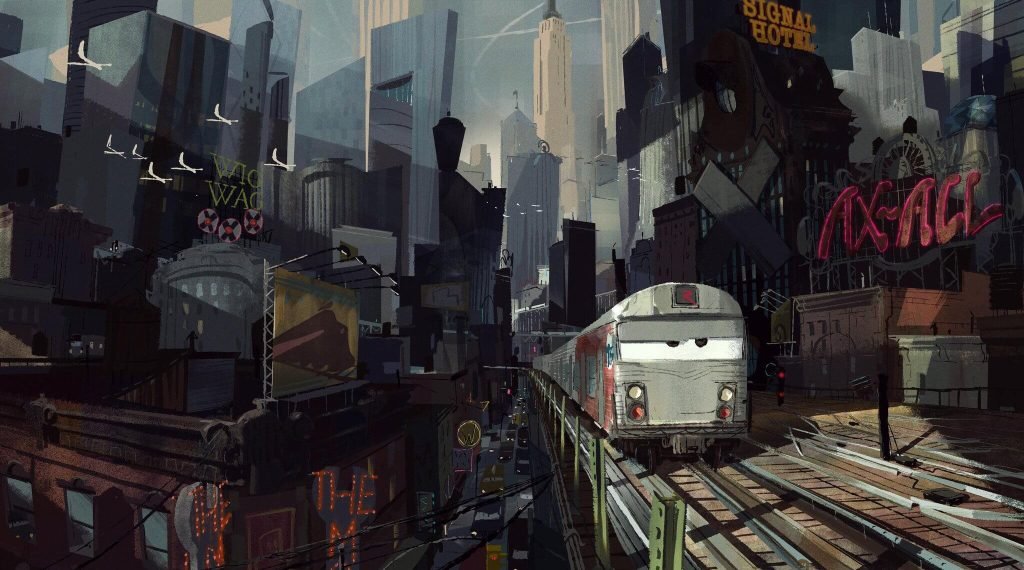
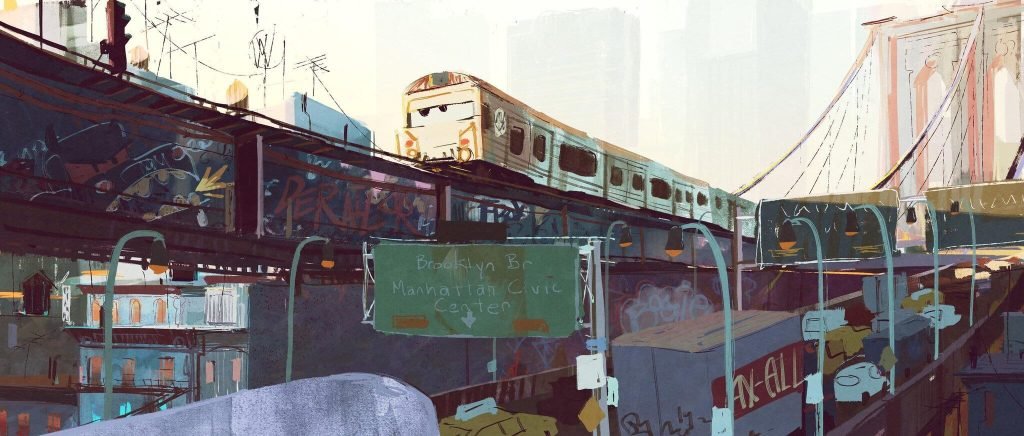
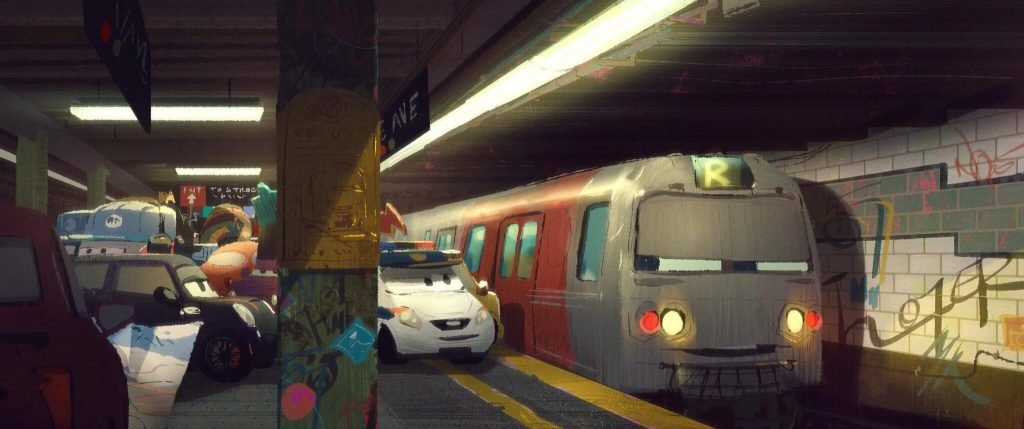
That said, it’s worth noting here that – just in the past year or so – we’ve seen Disney & Pixar attempt to expand the turf that these two characters could comfortably cover. Take – for example — “Cars on the Road,” that nine-part series which debuted on Disney+ back in September of last year. This collection of animated shorts literally sent Lightning McQueen & Mater off on a road trip.
So who knows?
Given that Bob Iger (at Disney’s quarterly earnings call held earlier this week) revealed that the Company now has sequels in the works for “Frozen,” “Toy Story,” and “Zootopia” … Well, is it really all that far-fetched to think that – at some point further on down the road – Disney & Pixar will put yet another sequel to “Cars” in the works?
One that might send Lightning McQueen & Mater off to explore the gritty inner-city world that we glimpsed in all that concept art for “Metro,” that never-produced “Cars” spin-off.
Time will tell.
-
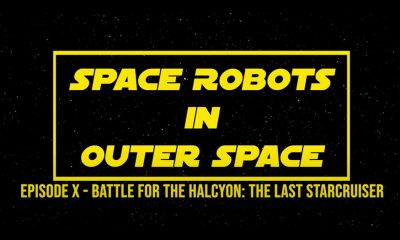
 News & Press Releases12 months ago
News & Press Releases12 months agoStar Wars Spoof: Space Robots in Outer Space Ep X: Battle for the Halcyon: The Last Starcruiser
-

 History11 months ago
History11 months ago31 Long-Gone Rides, Shows & Attractions at Disney-MGM (Hollywood Studios)
-

 News & Press Releases8 months ago
News & Press Releases8 months agoDisney Will Bring D23: The Ultimate Disney Fan Event to Anaheim, California in August 2024
-

 History4 months ago
History4 months agoFrom Birthday Wishes to Toontown Dreams: How Toontown Came to Be
-

 Theme Parks & Themed Entertainment12 months ago
Theme Parks & Themed Entertainment12 months agoFrom Aladdin to Indy – How Did We Get an Indiana Jones Stage Show at Disneyland?
-

 Theme Parks & Themed Entertainment12 months ago
Theme Parks & Themed Entertainment12 months agoHow Did We Get “Aladdin’s Oasis” at Disneyland?
-

 Theme Parks & Themed Entertainment10 months ago
Theme Parks & Themed Entertainment10 months agoWhen WDW Had a Racetrack – The Creation of the Walt Disney World Speedway
-

 Film & Movies10 months ago
Film & Movies10 months ago“Indiana Jones and the Search for Indiana Jones”








